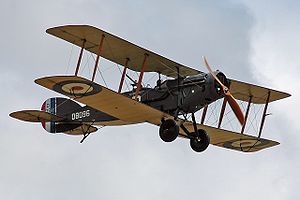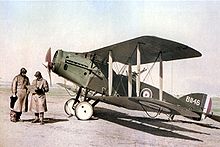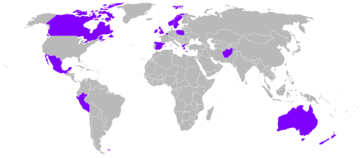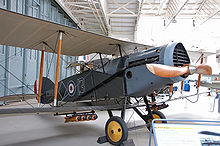Bristol F.2 Fighter Video - In flight
|
|
Bristol F.2 Fighter
Bristol F.2 Fighter

Picture - The Shuttleworth Collection's Bristol F.2B Fighter
Role: Biplane fighter aircraft
Manufacturer: British and Colonial Aeroplane Company
Designed by: Frank Barnwell
First flight: 9 September 1916
Retired: 1930s
Status: 1 preserved in the Shuttleworth Collection
Primary users: Royal Flying Corps
Polish Air Force
Produced: 1916-1927 (?)
Number built: 5,329
Unit cost: £1,350 (1918)
The Bristol F.2 Fighter was a British two-seat biplane fighter and reconnaissance aircraft of the First World War flown by the Royal Flying Corps. It is often simply called the Bristol Fighter or popularly the "Brisfit" or "Biff". Despite being a two-seater, the F.2B proved to be an agile aircraft that was able to hold its own against opposing single-seat fighters. Having overcome a disastrous start to its career, the F.2B's solid design ensured that it remained in military service into the 1930s, and surplus aircraft were popular in civil aviation.
Design and development
The Bristol fighter's basic design stemmed from design studies by Frank Barnwell in March 1916 for an aircraft in the same class as the R.E.8 and the F.K.8 - the Type 9 R.2A with the 160 hp Beardmore engine and the R.2B, powered by the 150 hp Hispano Suiza. Neither type was built as the new 190 hp (142 kW) Rolls-Royce Falcon I inline engine became available, and Barnwell designed a new aircraft around the Rolls-Royce engine. This, the Type 12 F.2A was a more compact design, intended from the outset as a two-seat fighter: it first flew on 9 September 1916. The F.2A was armed in what had by then become the standard manner for a British two-seater: one synchronised fixed, forward-firing .303 in (7.7 mm) Vickers machine gun, and one flexible .303 in (7.7 mm) Lewis Gun mounted on a Scarff ring in the observer's rear cockpit.
Only 52 F.2As were produced before production switched to what became the definitive Bristol Fighter, the Bristol Type 14 F.2B which had first flown on 25 October 1916. The first 150 or so were powered by the Falcon I or Falcon II engine but the remainder were equipped with the 275 hp (205 kW) Falcon III engine and could reach a maximum speed of 123 mph (198 km/h). The F.2B was over 10 mph (16 km/h) faster than the F.2A and was three minutes faster at reaching 10,000 ft (3,000 m). A second Lewis gun was often added to the rear cockpit.
The Bristol M.R.1 is often described as an "all-metal version of the F.2b". In fact it was a totally new design - although it shared the characteristic of having the fuselage positioned between the upper and lower wing. Two prototypes were built, the first flying on 23 October 1917, but the M.R.1 never entered mass production.
Alternative engines
Rolls Royce aero engines of all types were in chronic short supply in this period, and the Falcon was no exception. Plans to make the Bristol Fighter the standard British two-seater, replacing the R.E.8 and F.K.8, stalled against this barrier; there simply would not have been enough Falcons available. Efforts to find an available powerplant that was sufficiently powerful and reliable, ultimately failed.
The Type 15 was fitted with a 200 hp (150 kW) Sunbeam Arab piston engine. This motor suffered from chronic vibration and the "Arab Bristol" was never a viable combination, in spite of prolonged development. A few Arab-engined Bristols were at the front very late in the war - but most British reconnaissance squadrons had to soldier on with the R.E.8 and F.K.8 until the end of hostilities.
The Type 16 was fitted with a 200 hp (150 kW) Hispano-Suiza piston engine. This worked better than the Arab - but the Hispano-Suiza availability was no better than for the Falcon, and the motors that were available were required for the S.E.5a and Sopwith Dolphin. The 300 hp (220 kW) version of the Hispano-Suiza, suggested for the Type 17 was not available in numbers before the end of the war.
Other engines tried or suggested for the F.2B were the 200 hp (150 kW) RAF 4d, the 180 hp (130 kW) Wolseley Viper and the 230 hp (170 kW) Siddeley Puma.
The Type 22 F.2C was a proposed version adapted for a radial or rotary engine; either a 200 hp (150 kW) Salmson radial, a 300 hp (220 kW) ABC Dragonfly radial (Type 22A), or a 230 hp (170 kW) Bentley B.R.2 rotary (Type 22B).
American versions
The United States Army Engineering Division had plans to develop and build an American version of the Bristol Fighter. But efforts to start production in the United States foundered against the mistaken decision to power the type with the 400 hp (300 kW) Liberty L-12 engine - a totally unsuitable engine for the Bristol, as it was far too heavy and bulky, the resulting aircraft being nose heavy, with only 27 of the planned 2,000 being built. Efforts to change the powerplant of American Bristol Fighters to the more suitable Liberty 8 or the 300 hp (220 kW) Hispano-Suiza came up against political as well as technical problems, with one each of the Hispano-engined Engineering Division USB-1A and the Liberty L-8-engined Engineering Division USB-1B built. Limited numbers of aircraft designated XB-1 and later XB-1A (with Hispano or Wright engines) were built postwar.
Postwar developments
Postwar developments of the F.2B included the Type 14 F.2B Mk II, a two-seat army co-operation biplane, fitted with desert equipment and a tropical cooling system, which first flew in December 1919. 435 were built. The Type 96 Fighter Mk III and Type 96A Fighter Mk VI were structurally strengthened aircraft, of which 50 were built in 1926-1927.
Surplus F.2Bs were modified for civilian use. The Bristol Tourer was an F.2B fitted with a Siddeley Puma engine in place of the Falcon and with the cockpits enclosed by canopies. The Tourer had a maximum speed of 128 mph (206 km/h).
Operational history

Picture - A Bristol F.2B Fighter of No. 1 Squadron, Australian Flying Corps in Palestine, February 1918.
When initially deployed, aircrews were instructed to maintain formation and use the crossfire of the observers' guns to meet any threat from enemy fighters. This was standard procedure at the time, and worked well for such types as the F.E.2b. For the Bristol, these tactics were flawed and did not withstand the first contact with the enemy. The F.2A arrived on the Western Front in April 1917 as the British launched the Battle of Arras. The very first F.2A patrol of six aircraft from No. 48 Squadron RFC, led by Victoria Cross recipient William Leefe Robinson, ran into five Albatros D.IIIs from Jasta 11 led by Manfred von Richthofen. Four out of the six F.2As were shot down - including Robinson, who was captured - and a fifth was badly damaged.
More flexible, aggressive tactics soon proved that the new Bristol was by no means as ineffective in air-to-air combat as its first encounter with the enemy seemed to indicate. In fact it was eventually realised that the type was fast and manoeuvrable enough to be flown in combat more or less like a single-seat fighter; the pilot's fixed forward-firing gun served as the principal weapon, with the observer's flexible gun serving mainly as an additional "sting in the tail". Flown in this manner the Bristol Fighter was a formidable opponent for any German single-seater.
In September and October 1917, orders for 1,600 F.2Bs were placed and by the end of the First World War, the Royal Air Force had 1,583 F.2Bs in operation. A total of 5,329 aircraft were eventually built, mostly by Bristol but also by Standard Motors, Armstrong Whitworth and even the Cunard Steamship Company. After the war, F.2Bs continued to operate in army cooperation and light bombing roles throughout the British Empire, in particular the Middle East, India and China. The F.2B also served with the New Zealand Permanent Air Force and RAAF as well as with the air forces of Belgium, Canada, Ireland, Greece, Mexico, Norway, Peru, Spain and Sweden. It was not until 1932 that the F.2B was finally withdrawn from RAF service, the last "Brisfit" unit being No. 20 Squadron RAF stationed in India. The type lasted a further three years in New Zealand service.
In 1920 Poland bought 107 Bristol Fighters, thus becoming the second largest user of this type (105 with Hispano-Suiza 300 hp/220 kW engines, two with RR Falcon III). It was most numerous Polish aircraft type at that time. Forty were used during the Polish-Soviet war from July 1920, among others in battle of Warsaw, for reconnaissance and close air support. The rest became operational only after hostilities. Two were shot down by ground fire, one was captured by the Soviets and several were lost in crashes. They served in Poland for reconnaissance and training until 1932.
Operators

Picture - Bristol F.2 Fighter operators
Afghanistan
Afghan Air Force operated three aircraft from 1919 and retired by 1929.
Australia
Australian Flying Corps operated the Bristol Fighter from 1917 to 1918.
No. 1 Squadron in Palestine
No. 6 (Training) Squadron in the United Kingdom
Belgium
Belgian Air Force
Canada
Royal Canadian Air Force
Honduras
Honduran Air Force
Ireland
Irish Air Service
Irish Air Corps
Greece
Hellenic Air Force
Mexico New Zealand
New Zealand Permanent Air Force operated seven Bristol F.2B Fighters from 1919 to 1936. During its 16 years of service with the NZPAF, it was used as an Army Co-operation, aerial-survey and advanced training aircraft.
Norway
Norwegian Army Air Service
Peru Poland
Polish Air Force operated 107 Bristol F.2B Fighter in 1920-1932.
Kingdom of Spain
Spanish Air Force
Sweden
Royal Swedish Air Force
United Kingdom
Royal Flying Corps / Royal Air Force
No. 2 Squadron RAF
No. 4 Squadron RAF
No. 5 Squadron RAF
No. 6 Squadron RAF
No. 8 Squadron RAF
No. 9 Squadron RAF
No. 10 Squadron RAF
No. 11 Squadron RAF
No. 12 Squadron RAF
No. 13 Squadron RAF
No. 14 Squadron RAF
No. 16 Squadron RAF
No. 20 Squadron RAF
No. 22 Squadron RAF
No. 24 Squadron RAF
No. 28 Squadron RAF
No. 31 Squadron RAF
No. 33 Squadron RAF
No. 34 Squadron RAF
No. 35 Squadron RAF
No. 36 Squadron RAF
No. 39 Squadron RAF
No. 48 Squadron RAF
No. 62 Squadron RAF
No. 67 Squadron RAF
No. 75 Squadron RAF
No. 76 Squadron RAF
No. 81 Squadron RAF
No. 88 Squadron RAF
No. 100 Squadron RAF
No. 105 Squadron RAF
No. 111 Squadron RAF
No. 114 Squadron RAF
No. 138 Squadron RAF
No. 139 Squadron RAF
No. 140 Squadron RAF
No. 141 Squadron RAF
No. 186 Squadron RAF
No. 208 Squadron RAF
Survivors
There are three airworthy Bristol Fighters in 2007, (and several replicas):
The Shuttleworth Collection contains one airworthy F.2B Fighter, identity D8096, that still flies during the English summer.
The Canada Aviation and Space Museum owns a second example, D-7889.
The New Zealand film director Peter Jackson owns D-8040, which flies from the Omaka Aviation Heritage Centre, which also holds a second original fuselage.
Aircraft on display

Picture - A Bristol F.2 Fighter preserved at the Imperial War Museum Duxford
Substantially original aircraft are on static display at the:
Royal Air Force Museum London
Imperial War Museum Duxford
Museo del Aire, Madrid
VAF, Old Kingsbury, Texas
Musée Royal de l'Armée, Brussels.
Engineers at Rolls-Royce, Airbus and GKN Aerospace-Filton have also built a full-scale replica F.2B in celebration of 100 years of aircraft manufacture at Filton Bristol, where the original fighters were designed and built.
Specifications (F.2B)
General characteristics
Crew: 2 (pilot & observer/gunner)
Length: 25 ft 10 in (7.87 m)
Wingspan: 39 ft 3 in (11.96 m)
Height: 9 ft 9 in (2.97 m)
Wing area: 405 ft² (37.62 m²)
Empty weight: 2,145 lb (975 kg)
Max takeoff weight: 3,243 lb (1,474 kg)
Powerplant: 1x— Rolls-Royce Falcon III liquid-cooled V12 engine, 275 hp (205 kW)
Performance
Maximum speed: 123 mph (107 kn, 198 km/h) at 5,000 ft (1,500 m)
Range: 369 mi (320 nmi, 593 km)
Service ceiling: 18,000 ft (5,500 m)
Rate of climb: 889 ft/min (4.5 m/s)
Armament
Guns:
1x— .303 in (7.7 mm) forward-firing Vickers machine gun in the upper fuselage
1 or 2x— .303 in Lewis Guns in the observer's cockpit
Bombs: 240 lb (110 kg)
Related development
Bristol M.R.1
Bristol Tourer
Bibliography
Barnes, C.H. Bristol Aircraft since 1910. London: Putnam, 1964.
Bruce, J.M. "The Bristol Fighter". Flight, 7 November 1952, pp. 587-591.
Bruce, J.M. Warplanes of the First World War, Vol. 1. London: Macdonald, 1965.
Cheesman, E.F., ed. Fighter Aircraft of the 1914-1918 War. Letchworth, Harleyford, UK: Aero Publishers, Inc., 1960.
Gutman, J. Bristol F2 Fighter Aces of World War 1. London: Osprey Publishing, 2007. ISBN 978-1-84603-201-1.
Kopański, Tomasz Jan. Samoloty Brytyjskie w Lotnictwie Polskim 1918-1930 (British Aircraft in the Polish Air Force 1918-1930) (in Polish). Bellona, Warsaw: 2001. ISBN 83-11-09315-6.
Bristol F.2 Fighter Pictures
Living Warbirds: The best warbirds DVD series.
Source: WikiPedia